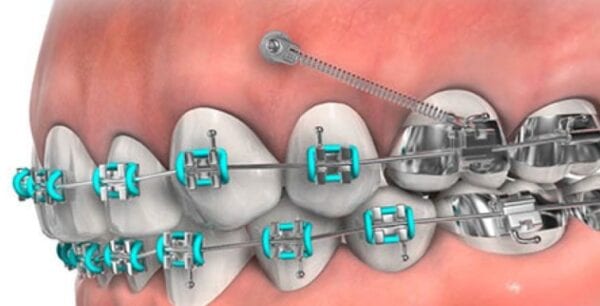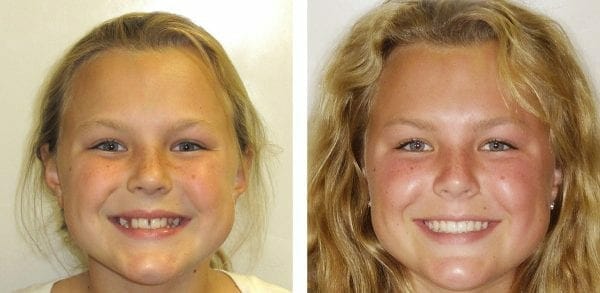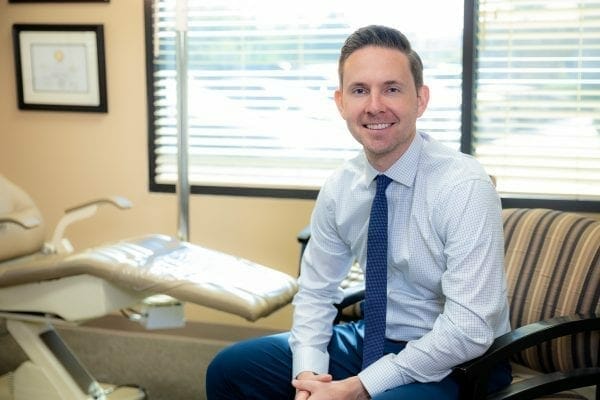Miniscrews (TADs) have transformed modern orthodontics by giving doctors a tiny, temporary “handle” on the bone—letting them move teeth with unprecedented precision and safety.
At Burke & Redford Orthodontists in Temecula and Lake Elsinore, Dr. Ryan Redford uses these devices to close open bites, close missing tooth sites, and finish smiles that once required headgear or jaw surgery.
Let us explain what miniscrews are, how they work, why 3-D imaging is essential for safe placement, and how Dr. Redford combines miniscrews with self-ligating Damon braces or Invisalign® to give Inland-Empire kids and teenagers great results in complicated cases. This orthodontic journey begins with a no-cost digital baseline scan for your children and teenagers in our office.

What Exactly is a Miniscrew?
Miniscrews, also called Temporary Anchorage Devices (TADs), are sterile titanium screws 6-12 mm long that are gently threaded through the gum into the cortical bone between teeth or in the palate. They provide an instant, non-moving anchor that is removed at the end of treatment. Success rates in children and teens routinely exceed 88-90 percent when good hygiene and light forces are used.
Why Anchorage Matters
To move a tooth, an “anchor” tooth or set of teeth is needed to provide a stabilizing force to enable this movement. Before miniscrews, orthodontists held anchor teeth steady with headgear, bulky acrylic plates, or by wiring many teeth together. Those methods relied on perfect wear or risked unwanted tooth movement. A miniscrew (TAD) lets Dr. Redford push, pull, intrude, or upright a single tooth (or an entire segment) without borrowing force from neighboring teeth.
CBCT: the Safety Net Behind Every Miniscrew
Burke & Redford Orthodontists place miniscrews only after a low-dose cone-beam CT scan pinpoints bone thickness, nerve and sinus location, and the safest angle for insertion. Research shows CBCT guidance sharply reduces root damage and increases primary stability.
How Miniscrews Enhance Common Pediatric Problems
| Clinical Goal | Traditional Limitation | Miniscrew Advantage |
|---|---|---|
| Close an anterior open bite | Vertical elastics rely on extruding the front teeth which are prone to relapse and instability. | Intrusion of the back molar teeth with TADs lets the orthodontist at burke and redford orthodontists intrude molars using 150 g light force, closing the bite in the front with increased stability. |
| Protract upper teeth when excess space is present or a tooth is missing | Headgear relies on nightly wear. | Buccal miniscrews apply constant pull 24/7—even for busy teens—when placed by a skilled orthodontist. |
| Correct Class III underbite early | Facemask pulls can flare incisors. | Skeletal anchorage moves the entire upper arch forward while keeping incisors upright—something burke and redford orthodontists specialize in. |
| Eliminate bulky appliances | Headgear is bulky and sometimes cumbersome. | Miniscrews used by the pediatric orthodontist are intraoral and not visible from outside the mouth. |
Pairing TADs with Our Orthodontic Appliances
Self-ligating Metal Braces
TADs are simply the anchor point for moving teeth. Self-ligating braces are what straighten the teeth and idealize the bite.

Self-ligating Ceramic Braces
For image-conscious teens, translucent brackets blend with enamel yet still use clips on each bracket to secure the archwire.
Invisalign® Teen
Aligners move teeth in 0.25 mm increments. When extra anchorage is needed, such as retracting canines far back, Dr. Redford programs the digital plan around miniscrew “buttons.” This ensures predictable movement without unwanted molar drift.
Gentle Forces Protect Growing Roots
Heavy, continuous forces (>300 g) are linked to greater external apical root resorption. Using miniscrews means:
- Lower force levels (100-150 g) achieve the same motion because nothing else is resisting.
- Shorter force duration – teeth reach the target sooner, cutting cumulative risk.
- Fewer round-trip movements, because anchorage is absolute.
Burke & Redford Orthodontists verify root health with mid-treatment panoramic images and, in high-risk cases, a small-field follow-up CBCT.

What are Questions Parents Often Ask About Miniscrews for their Children or Teenagers?
Does insertion of the miniscrew hurt?
A dab of topical gel plus local anesthetic makes placement virtually painless; most kids say it feels like an ear lobe piercing and resume normal eating the same day.
Can the miniscrew fall out?
A good hygiene routine and avoiding chewy and sticky foods keep success above 90 %. If a miniscrew loosens, it can be replaced.
Will the miniscrew damage permanent teeth?
CBCT-guided positioning keeps screws 1-2 mm from any root surface, and removal leaves only a pin-point dimple that heals in days.
Why Families Consistently Choose Dr. Ryan Redford
- Board-certified expertise – Dr. Redford is board certified with the American Board of Orthodontics.
- Tech-forward philosophy – In-house Planmeca CBCT and iTero® digital scanning mean every TAD (miniscrew) is planned carefully.
- Child-centered care – Appointments are quick, friendly, and parents view the 3-D plan on-screen, so they understand every step.
- Comprehensive orthodontic technology – From early expanders and space maintainers to clear braces and Invisalign Teen, all appliances are designed around the safest anchorage strategy for your child.
Dr. Redford leads miniscrew-guided treatments, ensuring continuity from evaluation to retainer.

Next Steps: A Complimentary 3-D Baseline Scan
The American Association of Orthodontists urges parents to schedule the first orthodontic visit by age 7, when problems are easiest to guide and the scan is quick and low dose. Burke & Redford Orthodontists provide that initial consultation for your child or teens, complete with digital photographs, and, when helpful, CBCT imaging—at no charge. You’ll leave with a clear picture of your child’s bite, growth potential, and whether miniscrew anchorage could simplify future treatment.
Ready to see how miniscrews can close missing tooth sites, close bites — all with fewer appointments?
📞 Call our office (951) 699-8011 or request your free orthodontic consultation through our website. Let Dr. Ryan Redford and the Burke & Redford Orthodontists team give your child the anchored advantage for a lifetime of confident smiles with braces in Temecula and the Inland Empire.